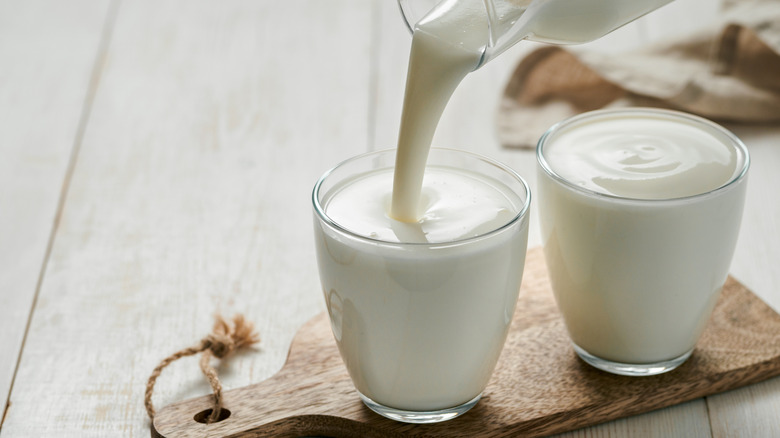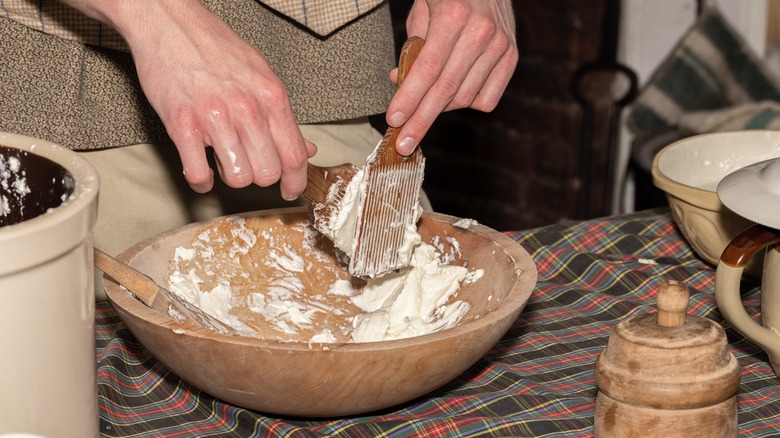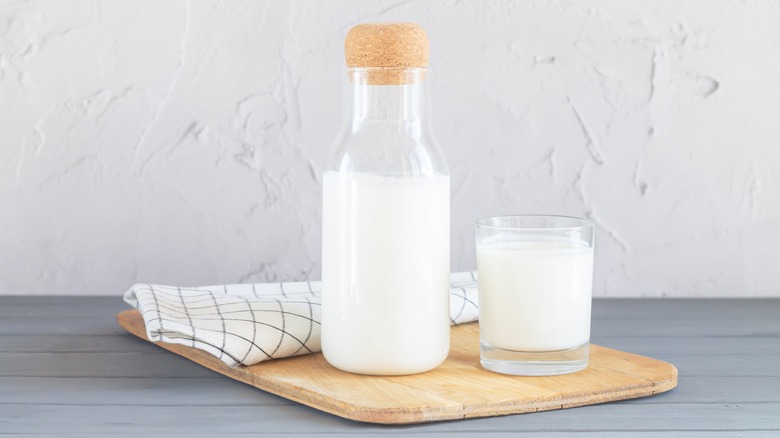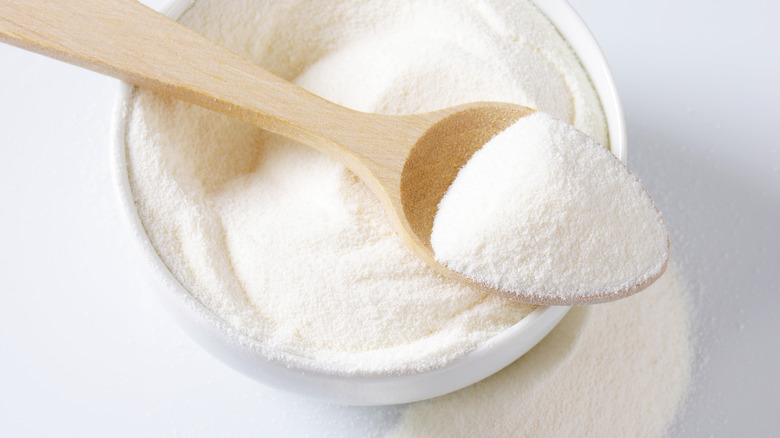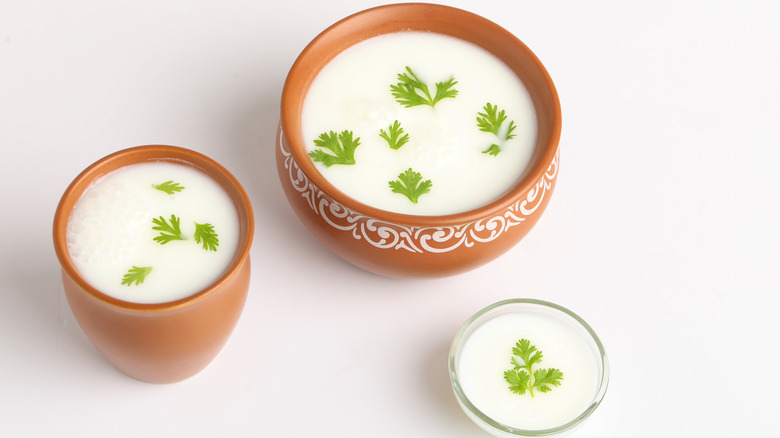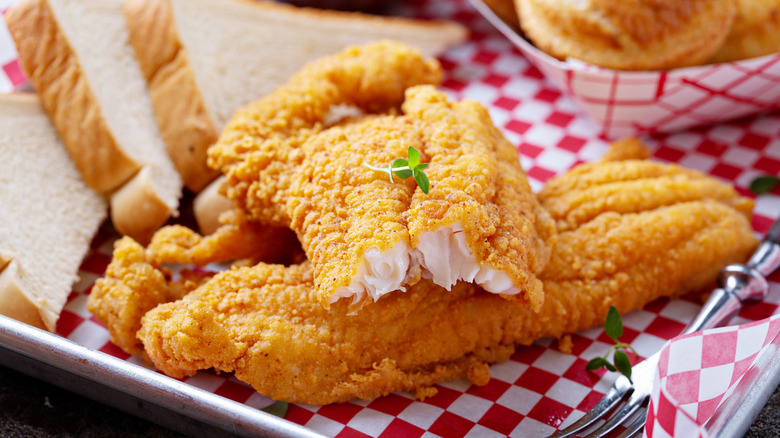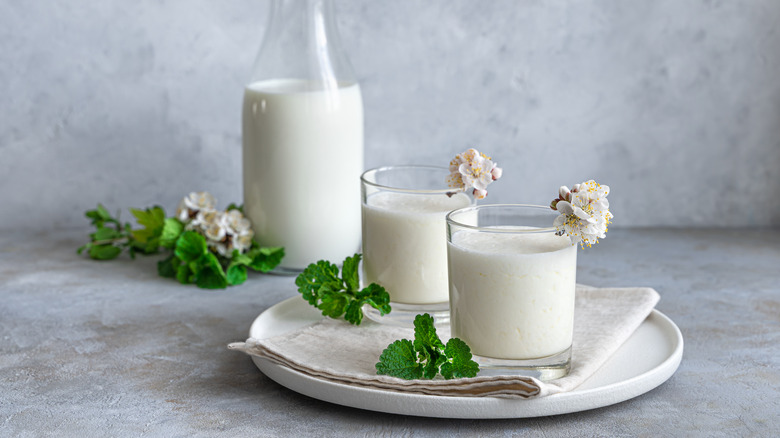What Is Buttermilk And How Do You Cook With It?
If you're still not sure what exactly buttermilk is, you're not alone, as its definition has changed over time. According to the Food Network, buttermilk is just milk that has undergone a fermentation process. Not only does this extra step result in thicker milk with lumps, but it gives it a mildly sour, tangy flavor.
Does sour, lumpy milk sound appealing? Most people may not want to drink cups of buttermilk (or even a sip), but there is more to this ingredient than meets the eye. Its flavor makes it an excellent addition to recipes like fried chicken, mashed potatoes, or cornbread since its tartness can provide a delicious balance to creamier tastes. But that's not all – Taste of Home also recommends using buttermilk to make desserts like red velvet cake, pancakes, and donuts.
To a buttermilk novice, the purpose behind it can be a perplexing conundrum. Let's delve into where this dairy product comes from, how to cook with it, and where to find it.
What is buttermilk?
To understand what buttermilk is, you first need to know how it was originally made. According to Southern Living, the first form of buttermilk was the milk left in the bottom of a churn after it was used to make butter. If you need a refresher on old-fashioned butter making, this process was deployed by pioneers back in the day using a plunger to separate cream from milk, which was then skimmed off the top and solidified into butter (via the Orange County Regional History Center).
Buttermilk you'll find on a grocery store shelf is generally not this butter by-product. The term is more commonly used to describe a fermented beverage made from milk. As Colleen Cruze Bhatti, co-owner of a dairy farm, told Eater, "I explain it as a drinkable yogurt. It's a cousin to yogurt, cousin to kefir." According to Epicurious, the version made from skim milk technically isn't buttermilk, but it's close enough that it doesn't raise a red flag from the federal government.
Though original buttermilk was made with cream, the drink can be made with whole milk, skim milk, or even buttermilk powder, according to Eater. But no matter which of these you use, the milk will likely taste similar — thick, tart, and acidic.
How is buttermilk made?
The old-fashioned method for making buttermilk held major advantages for the pioneers of its day. Back in the 18th century, milk spoiled quickly without refrigerators, and buttermilk could be left out for longer while it turned sour (via Slate). When pioneers churned milk, the high-fat cream would rise to the top and later make butter, Eater shares. The leftover liquid would turn sour, giving buttermilk its signature taste and smell and ward off harmful bacteria.
The buttermilk you'll find today isn't churned by hand. Brands mimic the authentic fermentation process by adding live cultures to milk, according to Country Living. The milk is then heated and left to ferment. If you're slightly put off by the thought of bacteria in your milk, think of Greek yogurt, another tart dairy product. The cultures in Greek yogurt, much like in buttermilk, help support a healthy gut and digestive system, per Livestrong.
When you're in a pinch and need to improvise adding buttermilk to a recipe, the Food Network recommends mixing milk with lemon juice or distilled white vinegar. While the resulting drink isn't a replica, it will provide the necessary acidic and dairy components present in true buttermilk.
Buttermilk vs. buttermilk powder
Most recipes involving buttermilk only require a small amount. For example, buttermilk blackberry scones only use a half cup plus two tablespoons. You can't buy that exact amount in stores, so you'll most likely end up with leftover buttermilk after making your recipe.
And although it's already a little sour, an opened container of buttermilk can go bad after two weeks and become extremely acidic, according to Foods Guy. So unless you're in a buttermilk baking frenzy, it's easy to waste it.
A modern-day solution to this dilemma is buttermilk powder. According to Food & Wine, the powdered version is made by drying out buttermilk until it has a flour-like texture. All you have to do to make it into actual buttermilk is mix it with water. King Arthur Baking shares that dried buttermilk doesn't sacrifice texture or flavor even after trying it in pie, cake, biscuits, and cookies.
The biggest advantage to buttermilk powder is, of course, its longevity. While the milk lasts about two weeks once opened, Honeyville shares that the powder can last up to a year. There are also a few recipes where it may be advantageous to use dried buttermilk — for example, it may make for a thicker ranch dressing (via The Kitchn).
What does buttermilk taste like?
Buttermilk is notorious for its sour, tart taste. While people may have drank it by itself back in the day due to lack of refrigeration, most people may find the flavor off-putting and don't consume it alone. However, the acidic nature of buttermilk makes it a great addition to creamier, fattier recipes.
Depending on how it's made, buttermilk can have slightly differing flavors. According to MedMunch, the original buttermilk leftover from churning butter tastes even more tart than the modern versions made from milk. However, the latter is typically richer than the old-school version (via Foods Guy).
Buttermilk is also known for its distinct texture. It's thick and creamy, generally denser than milk but thinner than yogurt. Southern Living notes that you can drink buttermilk, which can be a beneficial bedtime beverage due to its good-for-you bacteria. But would you want to? For those used to drinking regular milk, its fermented version is undoubtedly an acquired taste.
According to Foods Guy, the drink has a slightly yellow hue and a unique sour smell on its own. Although these may seem like signs of expiration, buttermilk hasn't gone bad until it tastes more sour than creamy or fizzes on top.
How to cook with buttermilk
Despite the common aversion to drinking it straight, buttermilk is a versatile ingredient. There are a variety of recipes in which buttermilk is the star of the show — think buttermilk donuts, pie, and mashed potatoes (via Taste of Home). If you're confused about how sour, thick, yellowish yogurt can make delicious dishes, buttermilk contains a secret element: emulsifiers.
According to Epicurious, the emulsifiers in buttermilk make for moist, creamy baked goods, even though the drink is generally low fat. A study published by Food Science & Nutrition reported that the emulsifiers in buttermilk might make for higher-quality ice cream, per the National Library of Medicine.
Even in dishes where buttermilk isn't the central ingredient, this beverage can bring a delicious tang to various recipes. According to Foods Guy, it's a staple in ranch dressing, fried chicken, and mac and cheese recipes. It can be a welcome addition to anything that could use a slightly sour bite, from potato salad to fried green tomatoes to corndogs, as noted by The Kitchn.
And when it comes to baked goods, buttermilk's benefits cannot be overstated. Not only does it provide a tangy flavor, but the liquid also acts as a leavening agent by reacting with baking soda, according to Food Network. This makes buttermilk the perfect ingredient in pancake, coffee cake, and biscuit recipes.
Where to buy buttermilk
Since cultured buttermilk is a modern-day dairy product, it's fairly easy to find in most grocery stores. According to Country Living, you should be able to find it in the dairy aisle of your nearest supermarket, next to the other types of milk. Chains like Whole Foods, Vons, and Wegmans generally carry cartons or bottles of the beverage.
Food Champs named Five Acre Farms, Organic Valley, and Barber's Dairy as some of the best buttermilk brands you can buy. However, it's also worth noting that farmers' markets may sell their own high-quality milk. While you can make it at home, store-bought is actually widely preferred. Cultured milk requires adding bacteria and allowing it to ferment, which is difficult to replicate at home (via The Kitchn).
If you're looking for the original cream-based buttermilk made the pioneer way, your search might get trickier. According to Epicurious, Maine-based company Kate's Butter is the only supplier of this version in the U.S. Their buttermilk is slow-churned from hormone-free New England cows, so you know you're getting the good stuff. And if you live in the Northeast, you're lucky — grocery stores like Whole Foods and Hannaford only sell it in this region.
Nutritional information about buttermilk
Overall, buttermilk is considered highly nutritious. While it adds richness and creaminess to any recipe, it's actually a low-fat drink. When it was churned by hand, all the fat would rise to the top and solidify to make butter, leaving the non-fat liquid behind. In today's buttermilk, however, the fat content corresponds to the milk that's used to make it — for example, skim milk also produces non-fat buttermilk (via Southern Living).
According to WebMD, the drink is high in protein — just one cup contains nine grams. It's also rich in vitamin A, vitamin D, calcium, and potassium. Like regular milk, these vitamins and minerals may build strong bones. Buttermilk may also help lower blood pressure and cholesterol, per Healthline. In addition, the fermentation process is famous for bringing health benefits to this beverage. WebMD notes that the "good" bacteria added to buttermilk function similarly to probiotics, which promote a healthy digestive system.
If you're lactose intolerant or allergic to milk, however, you may want to steer clear of this dairy drink. Although some lactose-intolerant people have an easier time consuming buttermilk than regular milk, Healthline states it can still cause stomach aches or diarrhea. Mayo Clinic confirms that buttermilk still contains proteins that cause milk allergies, just like the ones in whole and skim milk.
